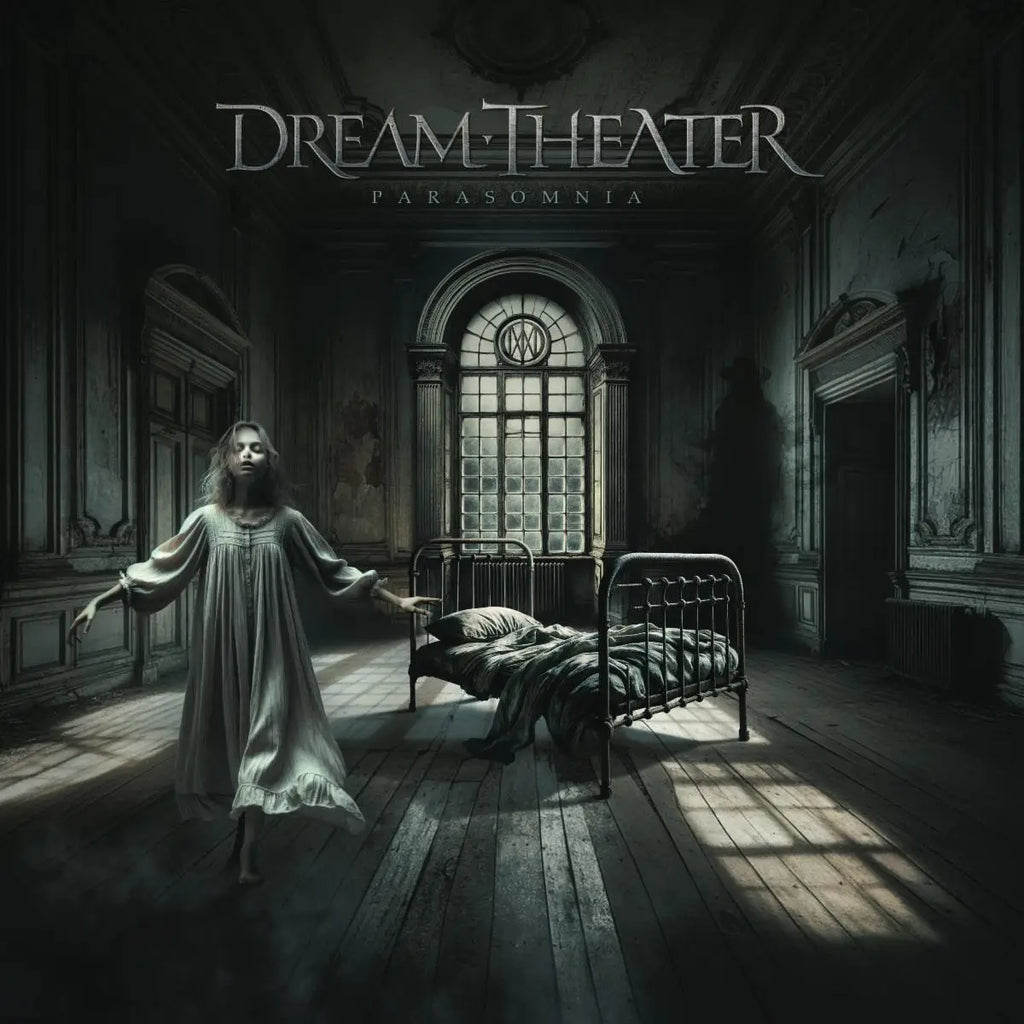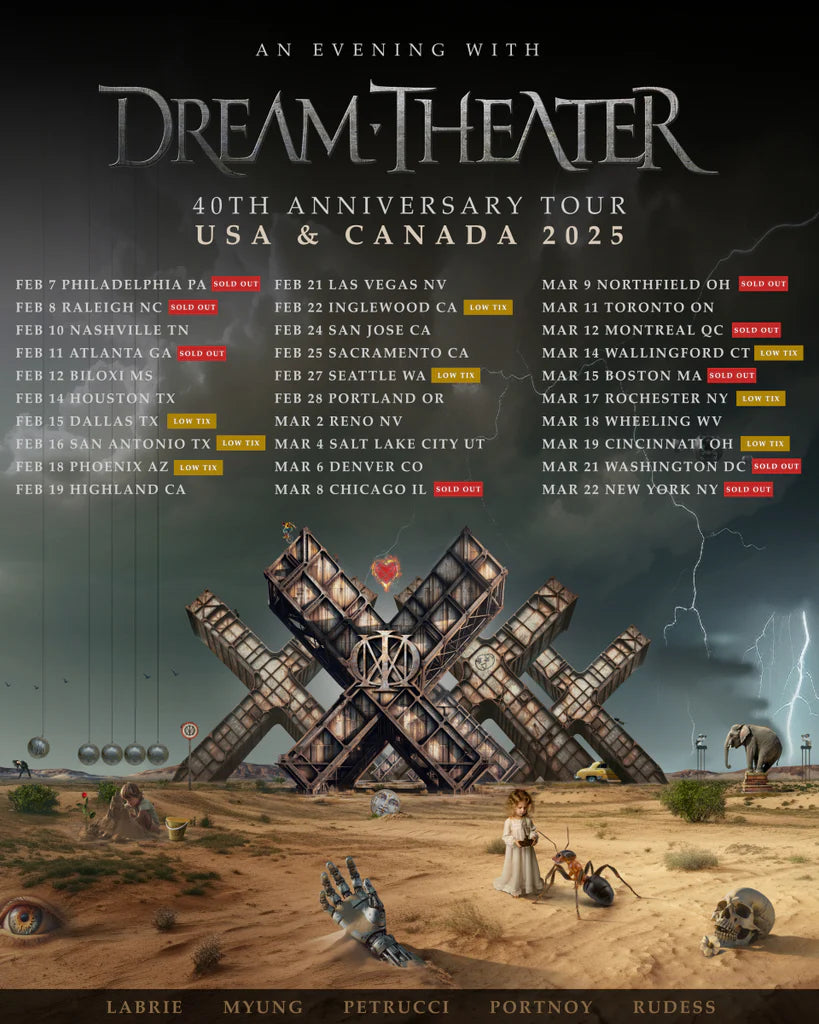Story by Jon Garcia / Photo by Steve Rose
Dream Theater has never been a band for the faint of heart. With song lengths that can rival an average sitcom runtime containing dizzying amounts of musical changes, solos, and movements, the prog metal masters have created a “love-it-or-leave-it” complexion in their 16 albums across four decades.
“There's such a wide audience that we have and no two fans are alike,” guitarist John Petrucci says. “People like different sides of Dream Theater. So for us the only way we can approach things is from our own creative minds and perspective.”
To this point it’s served them well, and it’s why he stresses that their newest record, Parasomnia, is an entity all its own that should be absorbed in full. The work that went into it fully embraced the Dream Theater spirit while, as always, pushing their identity forward.
“I know the way we consume music now has changed dramatically from what it was a long time ago, where people would put on a record like they were watching a movie,” he says. “But if you have the time, this album is meant to be listened to like that. It’s an experience.”
***
Fresh of winning a Grammy for their song “The Alien” on 2021’s A View from the Top of the World, the band – featuring Petrucci, vocalist Jame LaBrie, bassist John Myung, and keyboardist Jordan Rudess – found themselves reconnecting with drummer and founding member Mike Portnoy for the first time since 2009’s Black Clouds and Silver Linings.
It was purely happenstance, but Portnoy ended up being a pivotal piece of the Parasomnia puzzle.
Petrucci had known for years – even before Portnoy’s return – what the 16th Dream Theater album was going to be called. In a lightbulb moment, his son dropped the word “parasomnia” during a conversation about dreams.
“My first thought was ‘that's a perfect name for a Dream Theater album!’” Petrucci says. “It's always a challenge to come up with a one word album title that evokes imagery or sets a vibe.
He thought the word fit so well with the band name that he pitched making it the album’s lyrical content as well.
“All the songs would be about different parasomnia events. Sleep disturbances that are pretty scary and creepy. Night terrors and sleep paralysis and all this stuff.”
LaBrie sings about sleep disturbances stemming from PTSD (A Broken Man), wanting to live inside your dreams (Midnight Messiah), and accidentally killing someone in your sleep (Dead Asleep). The nearly 20-minute closer “The Shadow Man Incident” details an experience with a sleep paralysis figure known as “The Hat Man.”
But it was Portnoy who suggested while jamming that they take it a step further and make the music itself conceptual, tying recurring themes and little ear candy moments, and connecting the songs to make it more of an experience.
“The whole album is like a Dark Side of the Moon concept where it's a listening experience. It's not character story driven like some of our other concept albums, but it's an experience,” Petrucci says. It’s why he urges people to take in the whole thing at once.
***
Dream Theater have had their writing and recording process cemented for decades, and almost the same personnel that worked on their last album worked on this one. Recorded by engineer Jimmy T, mixed by Andy Sneap, and produced by Petrucci, only the room and the drummer were different. Petrucci credits that consistency to how proud they are of Parasomnia.
The band acquired their own writing and recording space six or seven years ago, but it was tiny compared to their sound. Still, they managed to record three albums there: Petrucci’s solo album Terminal Velocity; his project with Portnoy and Rudess, Liquid Tension Experiment 3; and A View From the Top of the World.
“We won a Grammy out of that small room,” Petrucci chuckles, “so we don’t need a lot of space.”
Ahead of Parasomnia, they acquired more room in the building and really beefed up their setup and really made it a space they felt themselves in.
“We were able to actually build a legit full size live room that's really beautiful and acoustically correct. We have room to have Mike’s giant Siamese monster drum kit and the grand piano, all the gear. It just felt comfortable and cool. The vibe is cool.”
The cool, comfortable vibe as well as the familiarity with Portnoy led to a Dream Theater record that sounds like it could be in any era. Just like Portnoy coming back to the band just “happened,” the instant chemistry and picking up where they left off led to an album that has a certain sense of nostalgia to it.
“We felt that when we were writing it, you know?” Petrucci says. “Even to the extent where as we’re writing a song we’re like, ‘Oh this feels like it could have been on Train of Thought’ or ‘this feels like something that would have belonged on [Metropolis Pt. 2:] Scenes from a Memory.’
“As those sort of nostalgic moments were happening, we had a choice: do we want to just not go there and really abandon anything from the past, or do we want to embrace and lean into it? We decided to embrace it, and looking back, there's a reason why there's that familiarity and in the sound that we have as a unit. When all was said and done it sounds like a brand new Dream Theater.
“It just occurred very organically, just as a result of Mike coming back and all of us having that energy that creates that kind of thing. So it's something that we are aware of and we're proud of it too.”
Dream Theater released Parasomnia in the middle of their 40th anniversary tour and worked two new songs into a set that spans their whole career.
“The excitement in the air, on stage and in the audience, it's so amazing,” Petrucci says. “There's so much celebration and joy about what we're doing. When we first started the tour the album wasn’t out yet. The only single was “Night Terror” so we started playing that. It sounds funny but it already feels like a classic song. You mix old and new and it all just works, you know? It all sounds like the same band.”
Eventually they’ll plan a Parasomnia-themed tour where they can really showcase the new songs. Petrucci already has ideas of turning the entire night into a theater of dreams with a full production.
“I can't wait till we bring this [record] live, because I think that'll be a really cool experience. Perform this in its entirety and have this whole real time, live parasomnia event for the audience. Maybe they'll all show up in their pajamas or something.”
***
Even 40 years into his career, Petrucci feels like he’s never run out of inspiration or excitement for his craft and for making new Dream Theater songs.
“I personally love playing guitar, so I'm always playing and as a result always writing. So for me, when we get to the point where we're ready to do another album I can't wait to get in there.
“It's amazing playing with all the guys in Dream Theater because they’re so talented that we all push each other. I never got to any point where I felt like there wasn't any mojo or will. I think that’s why we’re able to celebrate 40 years, we’re able to have 16 studio albums, and have fans still excited about new music and grow as a band.”
His musical hunger comes in all forms. “Dead Asleep” came about because of a jam session between himself and Black Label Society guitarist Zakk Wylde at John Petrucci’s Guitar Universe in 2023.
“Zakk Wylde does this drop B-flat tuning, which is this really heavy, cool kind of sound. So I had to tune to that to play some of his sounds and I was like, ‘I'm gonna write a song with this tuning, this is cool!’ So ‘Dead Asleep’ is that tuning. To me, the guitar just speaks in such a cool, heavy, evil way.”
It’s Petrucci’s favorite track, not just because of the tuning and the true story behind it – a man wakes up to find he’s killed his wife in his sleep and is eventually acquitted because of a prior history of sleep disturbances – but also because it’s where the main musical theme of Parasomnia originated.
“What I was trying to do on this album – knowing that it was going to be sort of dark, creepy, and we had to evoke the feeling of dreaming that surrealism – I started to study different composers of music and modes and chords and things that would do that. I had worked on this for a while and finally, I was so proud when I finally came up with it. It was like my version of a ‘Diary of a Madman,’ like creepy, classical chords. Then Jordan (Rudess) played this piano melody, and the Parasomnia theme came to be. So you hear it in this song very strongly in the beginning and at the end, and you hear it throughout the album.
***
Petrucci knows Dream Theater fans have high expectations and have their own opinions on what the band could and should sound like. But after 40 years he knows the only people they can listen to are themselves.
They don’t worry about what fans or critics might think. They can’t. Instead, with every song they ask themselves the same few questions:
“Is [the music] exciting? Is it cool? Does it feel good to play? Do these riffs make us smile and dig in? Are these the best performances that were captured at this point in everyone's lives on this record? The answer should be, and always is, ‘Yes.’ This is the best music and performance and sound that we can create at this period of time, putting 100% of our energy and heart into it, and that's the only way you can approach making any art, as far as I'm concerned.
“Then people will react to it as they will. You can't control that.”
Petrucci wants people to make up their own minds. He hopes that longtime Dream Theater fans will find as much to like in the album as someone who is sitting down to listen to the band for the first time. But above all, even if it’s not the norm anymore, he hopes people enjoy it as a full album.
“Maybe you’ll find yourself having a parasomnia event and you’ll see The Hat Man appear in the corner.”
-----
Parasomnia, the new album from Dream Theater is now available - HERE
Catch Dream Theater live on the band's US and Canada leg of their 40th anniversary tour. See the remaining dates and cities below. Get tickets - HERE


March 9 – Cleveland, OH – MGM Northfield Park (Sold Out)
March 11 – Toronto, ON – Coca-Cola Coliseum
March 12 – Montreal, QC – Place des Arts (Sold Out)
March 14 – Wallingford, CT – Oakdale Theater (Limited Tickets Remain)
March 15 – Boston. MA – Boch Center (Sold Out)
March 17 – Rochester, NY – Kodak (Limited Tickets Remain)
March 18 – Wheeling, WV – Capitol Theater
March 19 – Cincinnati, OH – Brady Music Center (Limited Tickets Remain)
March 21 – Washington, DC – The Anthem (Sold Out)
March 22 – New York, NY – Radio City Music Hall (Sold Out)




